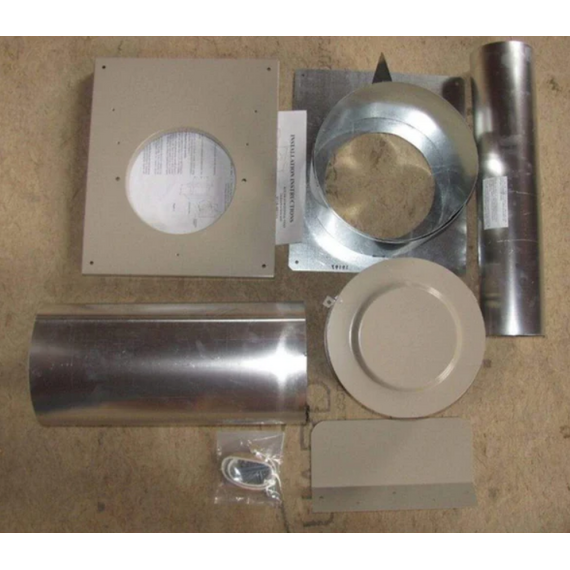Empire 4" x 6 5/8" Diameter Horizontal Vent Kit With Vinyl Siding Shield
This Empire 4" x 6 5/8" Diameter Horizontal Vent Kit With Vinyl Siding Shield is designed to provide a reliable and secure venting solution, ensuring your safety and peace of mind.
Features:
The DVVK4REVS Horizontal Vent Kit includes:
- Slimline Rectangular Vinyl Siding Wall Plate and Shield
- Small Round Beige Vent Cap
- Wall Thimble
- Collar
- Adaptor Plate
- Spring Spacer
- Gear Clamps
- 3 ft each of 4-in and 7-in. vent
Upgrade your chimney system with the DVVK4REVS for enhanced safety and performance.
Specifications:
- For walls up to 13.75 inches thick
- Horizontal direct vent kit for fireplace installations in homes with vinyl siding
- Compatible with all Tahoe Deluxe, 36" Tahoe Premium, and 36" Tahoe Luxury direct vent gas fireplaces
- Termination cap features vinyl siding shield
Downloads:
A Comprehensive Guide In Choosing a Vent Kit
A vent kit is a necessary part of many appliances, including boilers, furnaces, and water heaters, that release combustion byproducts. In order to ensure that these appliances operate safely and effectively and to reduce the risk of carbon monoxide poisoning, proper venting is essential. An extensive guide covering various types of vents, materials, installation, and safety issues is provided below for vent kits.
Types of Vent Kits:
1. Type B Vent Kits:
- Used for gas appliances that have a draft hood.
- Double-walled pipe with an air gap between the inner and outer walls.
- Suitable for vertical installations.
- Requires minimum clearances specified by the manufacturer.
2. Type L Vent Kits:
- Designed for venting oil-burning appliances.
- Similar to Type B but with different materials to withstand the corrosive effects of oil combustion.
3. Direct Vent Kits:
- Ideal for appliances that have sealed combustion systems.
- Bring in combustion air from the outside and expel exhaust gases outside.
- Can be installed horizontally or vertically.
4. Power Vent Kits:
- Used for appliances where natural draft venting is not feasible.
- Includes a fan to assist in the expulsion of combustion gases.
- Suitable for both vertical and horizontal installations.
5. Pellet Vent Kits:
- Designed for pellet stoves and inserts.
- Made of stainless steel and specifically engineered for pellet appliance exhaust.
Materials:
1. Stainless Steel:
- Commonly used for vent kits due to its corrosion resistance and durability.
- Available in single-wall or double-wall construction.
2. Aluminum:
- Lightweight and less expensive than stainless steel.
- Suitable for certain types of gas appliances.
3. Galvanized Steel:
- Budget-friendly option.
- Prone to corrosion and not suitable for high-efficiency appliances.
Installation Tips:
1. Follow the Manufacturer's Guidelines:
- Adhere to the installation instructions provided by the appliance and vent kit manufacturers.
2. Vent Sizing:
- Ensure the vent is appropriately sized for the appliance to maintain proper draft.
3. Clearances:
- Maintain required clearances from combustible materials as specified by the manufacturer.
4. Sealing Joints:
- Use approved sealants at joints to prevent gas leaks.
5. Support and Bracing:
- Provide proper support and bracing to ensure the vent remains secure.
Safety Considerations:
1. Carbon Monoxide Detection:
- Install carbon monoxide detectors near fuel-burning appliances and sleeping areas.
2. Regular Inspection:
- Periodically inspect the vent system for signs of damage or corrosion.
3. Professional Installation:
- Hire a qualified technician to install the vent kit to ensure compliance with local codes and safety standards.
4. Clear Vent Paths:
- Keep the vent paths clear of obstructions to prevent blockages.
5. Regular Maintenance:
- Follow the recommended maintenance schedule to keep the venting system in good condition.
You can guarantee the efficient and secure venting of combustion byproducts from your appliances by being aware of the various kinds of vent kits, selecting the right materials, adhering to the right installation techniques, and placing a high priority on safety. For detailed advice relating to your appliance and the building codes in your area, always seek the advice of a certified professional.
Manufacturer's Warranty
NAPOLEON products are manufactured under the strict Standard of the world recognized ISO 9001 : 2008 Quality Assurance Certificate. NAPOLEON products are designed with superior components and materials assembled by trained craftsmen who take great pride in their work. The burner and valve assembly are leak and test-fired at a quality test station. The complete appliance is again thoroughly inspected by a qualifi ed technician before packaging to ensure that you, the customer, receives the quality product that you expect from NAPOLEON. The following materials and workmanship in your new NAPOLEON gas appliance are warranted against defects for as long as you own the appliance. This covers: combustion chamber, heat exchanger, stainless steel burner, phazer™ logs and embers, rocks, ceramic glass (thermal breakage only), gold plated parts against tarnishing, porcelainized enameled components and aluminum extrusion trims.* Electrical (110V and millivolt) components and wearable parts are covered and NAPOLEON will provide replacement parts free of charge during the fi rst year of the limited warranty. This covers: blowers, gas valves, thermal switch, switches, wiring, remote controls, ignitor, gasketing, and pilot assembly.* Labour related to warranty repair is covered free of charge during the fi rst year. Repair work, however, requires the prior approval of an authorized company offi cial. Labour costs to the account of NAPOLEON are based on a predetermined rate schedule and any repair work must be done through an authorized NAPOLEON dealer. * Construction of models vary. Warranty applies only to components included with your specifi c appliance. NAPOLEON GAS APPLIANCE PRESIDENT’S LIFETIME LIMITED WARRANTY
No reviews found


